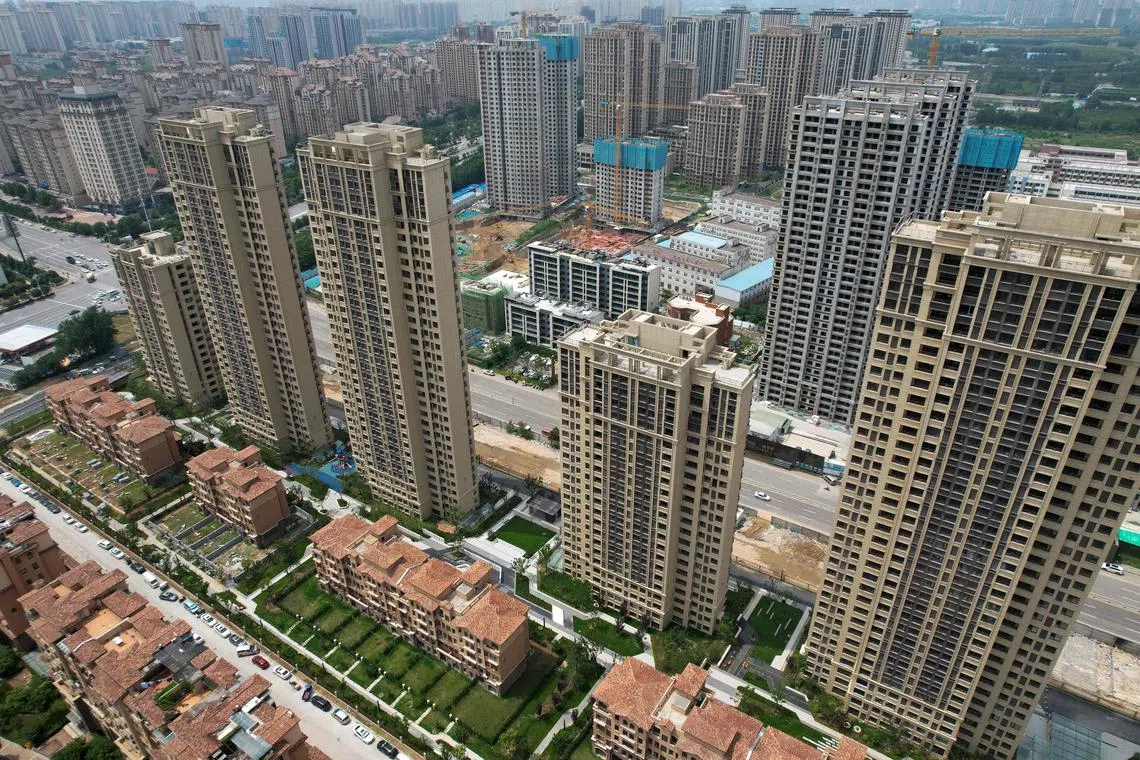China’s housing slump much worse than official data shows
Sign up now: Get ST's newsletters delivered to your inbox

Industry insiders and economists say China’s official home price indexes are likely understating the depth of the downturn.
PHOTO: AFP
Follow topic:
SHANGHAI – Judging by China’s official statistics, the nation’s housing market has been remarkably resilient in the face of tepid economic growth and record defaults by developers.
New home prices have slipped just 2.4 per cent from a high
But the picture emerging from property agents and private data providers is far more dire.
These figures show existing home prices falling at least 15 per cent in the prime neighbourhoods of major metropolitan areas such as Shanghai and Shenzhen, as well as in more than half of China’s tier-2 and tier-3 cities. Prices for existing homes near Alibaba Group Holding’s headquarters in Hangzhou have dropped about 25 per cent from late 2021 highs, according to local agents.
While it is difficult to make comparisons, industry insiders and economists say China’s official home price indexes are likely understating the depth of the downturn, in part because of longstanding methodologies that struggle to capture market turning points.
This is heightening concern among investors about the availability of timely economic data in China, where access to some information has become increasingly restricted under the government of President Xi Jinping.
It also raises questions about whether policymakers themselves have an accurate understanding of the market as they devise measures to prop up demand. Another risk is that wary home buyers stay on the sidelines, waiting for price declines to show up in the data before they step in.
Analysts say the methodology, which partly relies on surveys rather than price data from transactions, helps the authorities to smooth the trend and avoid large swings. By contrast, in the United States, the widely cited S&P CoreLogic Case-Shiller indexes use home price data collected at local deed recording offices across the country.
Dr Henry Chin, who has spent over 20 years researching global real estate markets, said the data’s source and accuracy are critical.
“Home price data in many countries is based on total market transactions, yet China uses selective samples,” said Dr Chin, the head of research for Asia-Pacific at CBRE Group. “When a market goes down, the true market condition is hard to be reflected in such data.”
China’s National Bureau of Statistics (NBS) has said in an online explanation that raw data on new home prices is based on all sales and purchases registered in local housing transaction bodies. Existing home prices, though, are based on both sales of key projects and surveys, it said. The NBS uses the Laspeyres price index, a common formula used worldwide, to calculate its 70-city home price gauge, it told Bloomberg. Market watchers say the methodology on sampling and index calculation remains ambiguous.
Survey-based data “serves a purpose of avoiding extreme fluctuation”, said Dr Alicia Garcia Herrero, chief Asia-Pacific economist at Natixis in Hong Kong. “But when people are wary that prices are falling even more, thus not buying, such data defeats its own purpose.”
Price slides
In Hangzhou, close to where Alibaba is headquartered, home prices in some neighborhoods are down 25 per cent to 28 per cent from a peak around October 2021, agents said. In Lianyang, a downtown area popular with expats and financiers in Shanghai, residential prices have slid 15 per cent to 20 per cent from record highs in mid-2021, they said.
Even as at March, before a fresh slowdown, more than half of tier-2 and tier-3 cities saw existing home prices fall over 15 per cent from their peaks, Guolian Securities economists wrote in a report, citing data by housing transaction services provider KE Holdings. Actual declines from peaks could be sharper as the agency compiles only data starting from November 2018, the economists cautioned.
Top cities, once considered resilient against a housing downturn, are not immune. Prices of existing homes in at least five popular districts of Shenzhen have slumped 15 per cent in the past three years, according to a July report by property research institute Leyoujia. The southern hub is the country’s least affordable housing market.
All data sources in China, be it government or private ones, face “significant challenges” in compiling a portfolio that is relatively stable for tracking home prices, Goldman Sachs China economists wrote in a July report. In their assessment of China home price measures, they said there is “no perfect” gauge.
“Property weakness is perhaps the most challenging growth headwind amid China’s ongoing post-reopening recovery, and thus the momentum and sentiment in the property sector have significant implications for growth and policies,” they said.
The perception gap on home prices stems in part from the vast array of policy levers the authorities have at their disposal. While countries such as Australia, Singapore and the US tend to tighten loan-to-value limits or lift interest rates, China can go beyond this to ban anyone not born in a particular city from purchasing homes there or limiting the number of properties a person is allowed to own.
“The weaknesses in housing price statistics hardly make things better,” said Mr Bert Hofman, former China country director for the World Bank, who is now at the National University of Singapore. “(This) may now work against determining the right policy to stabilise the market.” BLOOMBERG

